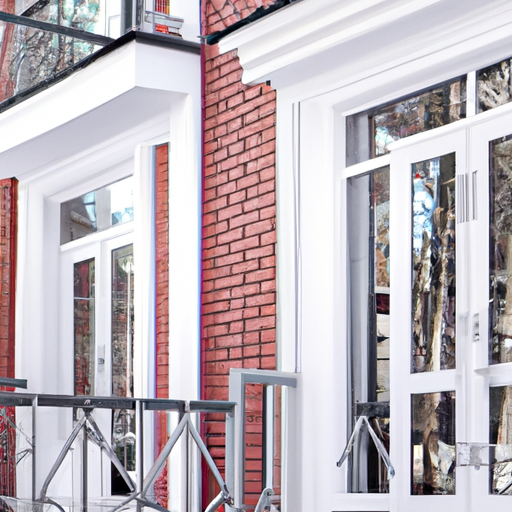Achieving Harmony: The Role of Architectural Consistency in Home Design
The importance of architectural consistency in your home’s design cannot be overstated. A well-designed home is not only aesthetically pleasing but also functional and comfortable. Achieving harmony in your home’s design is essential for creating a space that is both inviting and visually appealing. Architectural consistency plays a significant role in achieving this harmony, as it ensures that all elements of your home’s design work together seamlessly. This article will explore the importance of architectural consistency in your home’s design and provide some tips for achieving a harmonious and cohesive look.
Architectural consistency refers to the uniformity and coherence of design elements throughout a space. This can include everything from the choice of materials and finishes to the overall layout and flow of the space. When a home’s design is architecturally consistent, it creates a sense of unity and balance, making the space feel more comfortable and inviting. In contrast, a lack of consistency can lead to a disjointed and chaotic appearance, which can be both visually unappealing and functionally problematic.
One of the primary benefits of architectural consistency is that it helps to create a sense of flow throughout your home. When all elements of your home’s design work together harmoniously, it is easier for the eye to move from one area to another, creating a sense of continuity and connection between spaces. This can be particularly important in open-concept homes, where a lack of consistency can make the space feel disjointed and disconnected.
Architectural consistency also plays a crucial role in establishing a home’s overall style and aesthetic. When all elements of a home’s design are consistent, it creates a cohesive look that is both visually appealing and easy to understand. This can be particularly important when it comes to selling your home, as potential buyers are more likely to be drawn to a home with a clear and consistent design aesthetic.
In addition to its aesthetic benefits, architectural consistency can also have functional advantages. A well-designed home with consistent architectural elements is often easier to navigate and more comfortable to live in. For example, consistent door and window styles can make it easier to find your way around your home, while consistent flooring materials can create a more seamless transition between spaces.
Achieving architectural consistency in your home’s design may seem like a daunting task, but there are several strategies you can employ to help create a harmonious and cohesive look. One of the most effective ways to ensure consistency is to establish a clear design concept or theme at the outset of your project. This can help guide your decisions about materials, finishes, and other design elements, ensuring that all aspects of your home’s design work together seamlessly.
Another important aspect of achieving architectural consistency is to pay close attention to the scale and proportion of your home’s design elements. Ensuring that all elements of your home’s design are appropriately sized and proportioned can help create a sense of balance and harmony throughout the space.
Finally, it is essential to consider the relationship between your home’s interior and exterior design. A consistent design aesthetic that extends from the exterior of your home to its interior spaces can create a strong sense of continuity and cohesion, making your home feel more unified and inviting.
In conclusion, architectural consistency is a critical component of achieving harmony in your home’s design. By ensuring that all elements of your home’s design work together seamlessly, you can create a space that is both visually appealing and functionally comfortable. Whether you are building a new home or renovating an existing one, prioritizing architectural consistency can help you achieve a harmonious and cohesive look that will stand the test of time.
Balancing Aesthetics and Functionality: The Value of Architectural Consistency in Residential Spaces

The importance of architectural consistency in your home’s design cannot be overstated. A well-designed home is not only visually appealing but also functional, comfortable, and efficient. Achieving this balance between aesthetics and functionality requires a thoughtful approach to the design process, taking into consideration the various elements that contribute to a cohesive and harmonious living space. This article will explore the value of architectural consistency in residential spaces, highlighting the benefits of a unified design and offering tips for achieving a balanced and visually pleasing home.
Architectural consistency refers to the harmonious integration of various design elements, such as materials, colors, textures, and styles, to create a unified and coherent aesthetic. This concept is particularly important in residential spaces, where the overall design should reflect the homeowner’s personal taste and preferences while also providing a comfortable and functional living environment. A consistent design not only enhances the visual appeal of a home but also contributes to its overall efficiency and functionality.
One of the primary benefits of architectural consistency is the creation of a visually pleasing and harmonious living space. A well-designed home should have a clear and consistent theme, with each room and area complementing and reinforcing the overall aesthetic. This can be achieved through the careful selection of materials, colors, and finishes, as well as the thoughtful arrangement of furniture and decorative elements. A consistent design helps to create a sense of flow and continuity throughout the home, making it feel more spacious and inviting.
In addition to its aesthetic benefits, architectural consistency also contributes to the overall functionality and efficiency of a home. A well-planned design takes into consideration the needs and preferences of the homeowner, ensuring that each space is tailored to their specific requirements. This may involve the strategic placement of windows and doors to maximize natural light and ventilation, the incorporation of storage solutions to minimize clutter, or the selection of materials and finishes that are both durable and easy to maintain. By creating a cohesive and consistent design, homeowners can enjoy a living space that is not only visually appealing but also practical and efficient.
Achieving architectural consistency in your home’s design requires a thoughtful and deliberate approach to the design process. One of the first steps is to establish a clear and consistent theme or style, which will serve as the foundation for the overall design. This may involve researching different architectural styles, such as modern, traditional, or transitional, and selecting one that resonates with your personal taste and preferences.
Once a theme has been established, it is important to consider the various design elements that will contribute to the overall aesthetic. This may include the selection of materials, colors, and finishes, as well as the arrangement of furniture and decorative elements. It is important to ensure that each element is consistent with the chosen theme and contributes to the overall harmony of the design.
In addition to the visual aspects of the design, it is also important to consider the functional requirements of the home. This may involve assessing the needs and preferences of the homeowner, as well as the specific characteristics of the site and location. By taking these factors into consideration, it is possible to create a design that is not only visually appealing but also practical and efficient.
In conclusion, architectural consistency is a crucial aspect of residential design, contributing to both the aesthetic appeal and functionality of a home. By establishing a clear and consistent theme, selecting appropriate design elements, and considering the functional requirements of the space, homeowners can enjoy a living environment that is both visually pleasing and efficient.
Unifying Elements: How Architectural Consistency Enhances Your Home’s Visual Appeal
The importance of architectural consistency in your home’s design cannot be overstated. A well-designed home is not only visually appealing but also creates a sense of harmony and balance. Architectural consistency refers to the unifying elements that tie together the various components of a building, creating a cohesive and visually pleasing whole. This is achieved through the careful selection and arrangement of materials, colors, textures, and architectural features. By incorporating these elements into your home’s design, you can create a space that is both functional and aesthetically pleasing.
One of the key aspects of architectural consistency is the use of a consistent color palette throughout your home. This does not mean that every room must be painted the same color, but rather that the colors used should complement one another and create a sense of continuity. By using a consistent color scheme, you can create a sense of flow and unity throughout your home, making it feel more spacious and inviting.
In addition to color, the materials used in your home’s construction can also contribute to its architectural consistency. By using similar materials throughout your home, you can create a sense of cohesion and harmony. For example, if your home features exposed brick walls, consider using brick accents in other areas of the home, such as a brick fireplace or brick pavers in the outdoor living space. Similarly, if your home has hardwood floors, consider incorporating wood accents in other areas, such as wooden beams or built-in cabinetry.
Texture is another important element of architectural consistency. By incorporating similar textures throughout your home, you can create a sense of depth and interest. For example, if your home features smooth, polished surfaces, consider using similar materials in other areas, such as sleek, modern furniture or glossy countertops. Conversely, if your home has a more rustic, textured feel, consider incorporating natural materials like stone or wood in other areas of the design.
Architectural features, such as windows, doors, and molding, can also contribute to the overall consistency of your home’s design. By selecting features that are consistent in style and proportion, you can create a sense of harmony and balance throughout your home. For example, if your home features large, floor-to-ceiling windows, consider incorporating similarly proportioned windows in other areas of the home. Similarly, if your home has ornate molding, consider using similar molding in other areas of the design.
In addition to creating a visually appealing space, architectural consistency can also have practical benefits. A well-designed home is often more energy-efficient, as consistent design elements can help to regulate temperature and reduce energy consumption. For example, by using similar materials throughout your home, you can create a more consistent thermal envelope, which can help to keep your home cooler in the summer and warmer in the winter.
Furthermore, a consistent design can also make your home more functional. By incorporating similar architectural features throughout your home, you can create a sense of continuity and flow, making it easier to navigate and use the space. For example, by using consistent door and window styles, you can create a more intuitive layout, making it easier for occupants to move from one room to another.
In conclusion, architectural consistency is an essential aspect of a well-designed home. By incorporating unifying elements such as color, materials, textures, and architectural features, you can create a visually appealing and functional space that enhances your home’s overall appeal. By paying attention to these details, you can create a home that is not only beautiful but also comfortable and efficient, ensuring that your investment in your home’s design is well worth the effort.
Q&A
Question 1: Why is architectural consistency important in a home’s design?
Answer 1: Architectural consistency is important in a home’s design because it creates a harmonious and visually appealing environment, enhances the overall aesthetic, and can increase the property’s value. Consistency in design elements, materials, and style ensures a cohesive look and feel throughout the home, making it more comfortable and inviting.
Question 2: How does architectural consistency affect the functionality of a home?
Answer 2: Architectural consistency affects the functionality of a home by ensuring that spaces flow seamlessly from one area to another, improving the overall layout and usability of the space. Consistent design elements and materials can also contribute to better energy efficiency, as well as easier maintenance and cleaning.
Question 3: What are some ways to achieve architectural consistency in a home’s design?
Answer 3: To achieve architectural consistency in a home’s design, consider the following strategies: 1) Choose a specific design style or theme and apply it throughout the home; 2) Use a consistent color palette and materials for finishes, fixtures, and furnishings; 3) Ensure that architectural elements, such as windows, doors, and moldings, are consistent in style and proportion; 4) Plan the layout of the home to create a natural flow between spaces; and 5) Incorporate consistent lighting design to create a cohesive ambiance throughout the home.
Conclusion
In conclusion, architectural consistency in a home’s design is crucial for achieving a harmonious and aesthetically pleasing living space. It ensures a seamless flow between rooms, enhances the overall visual appeal, and can even contribute to the home’s functionality and value. By maintaining a consistent design theme, homeowners can create a cohesive and inviting atmosphere that reflects their personal style and preferences.


